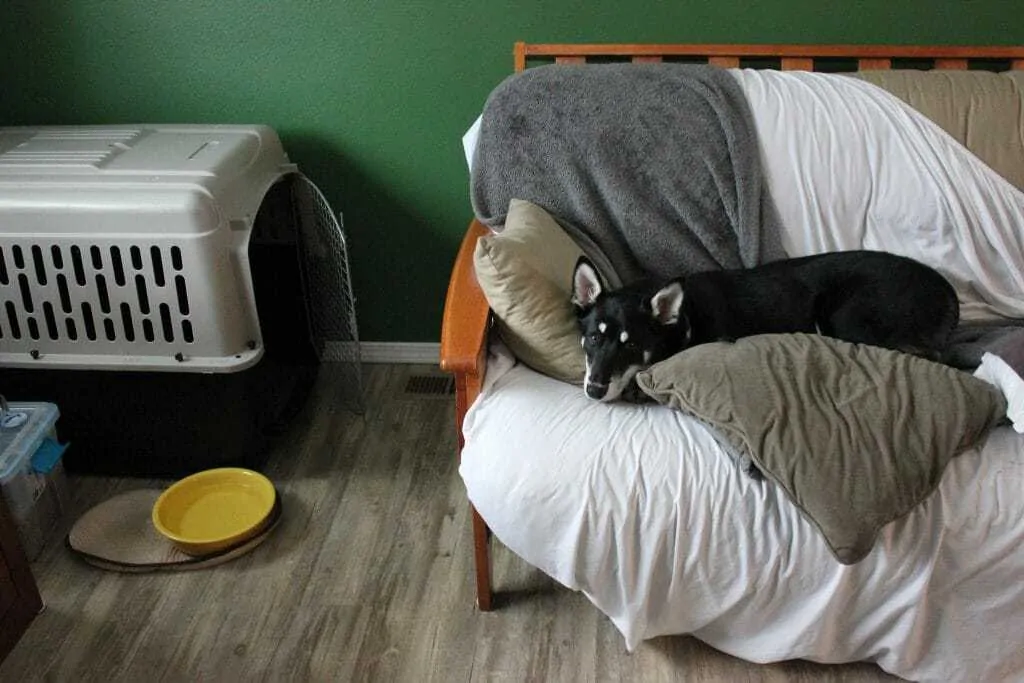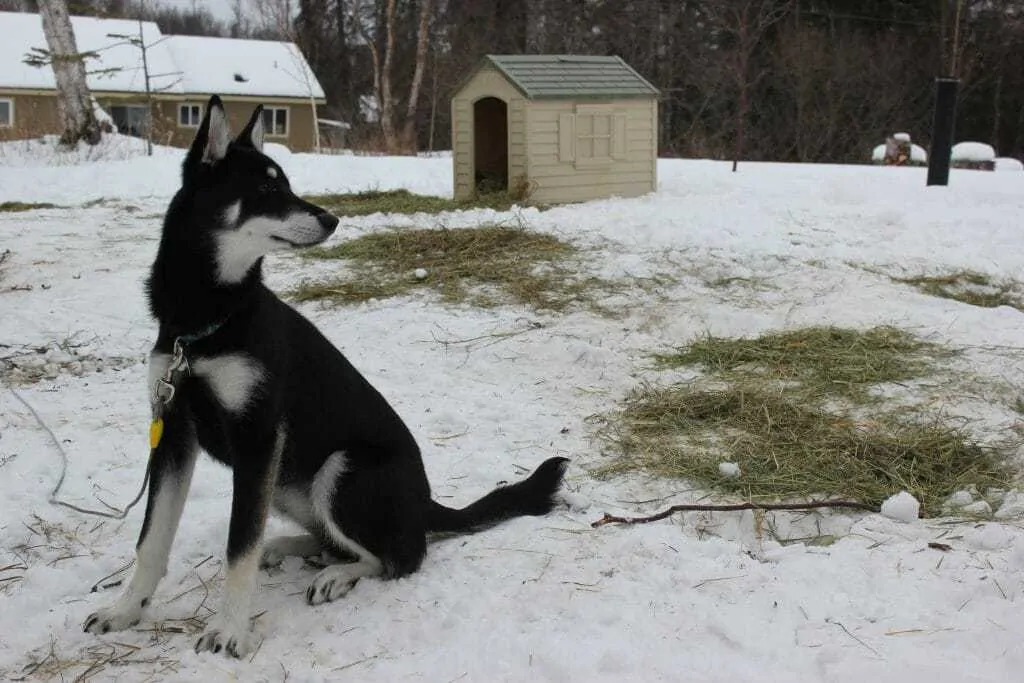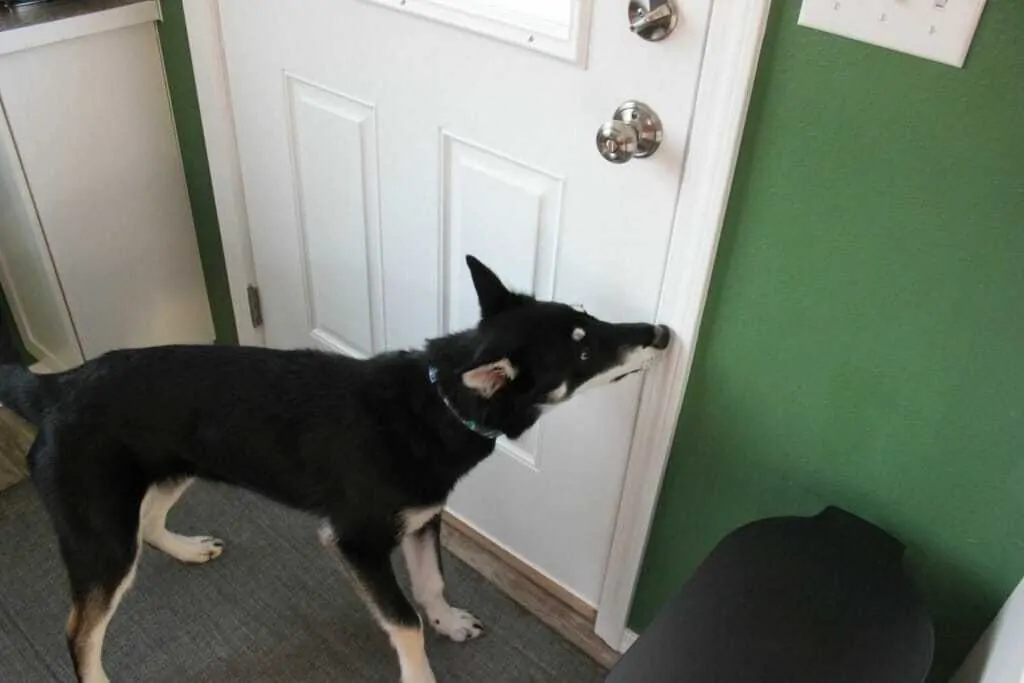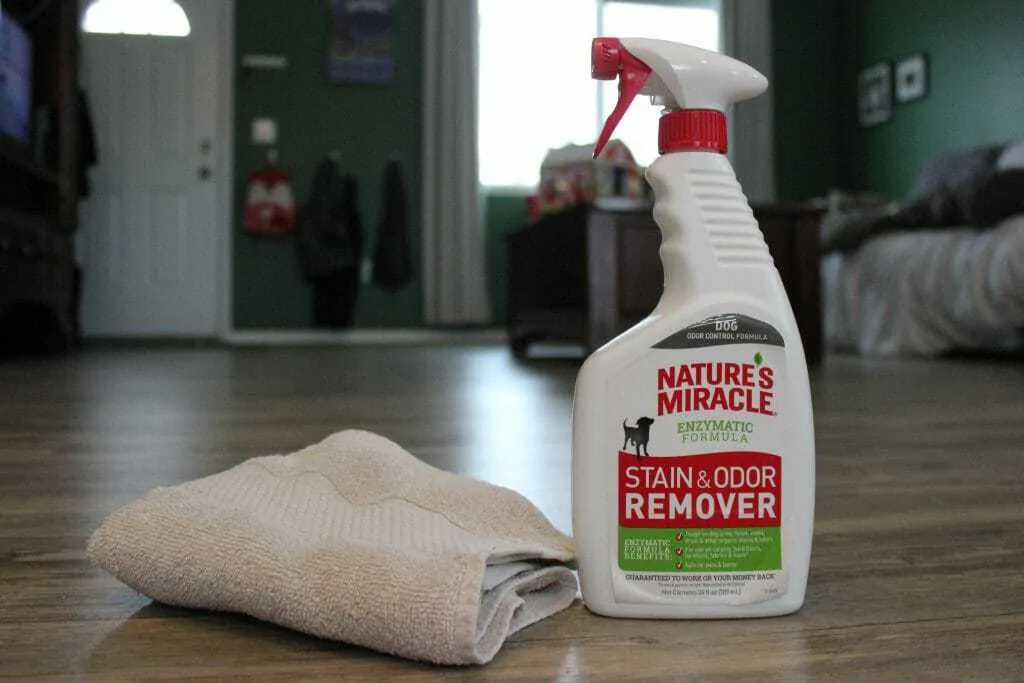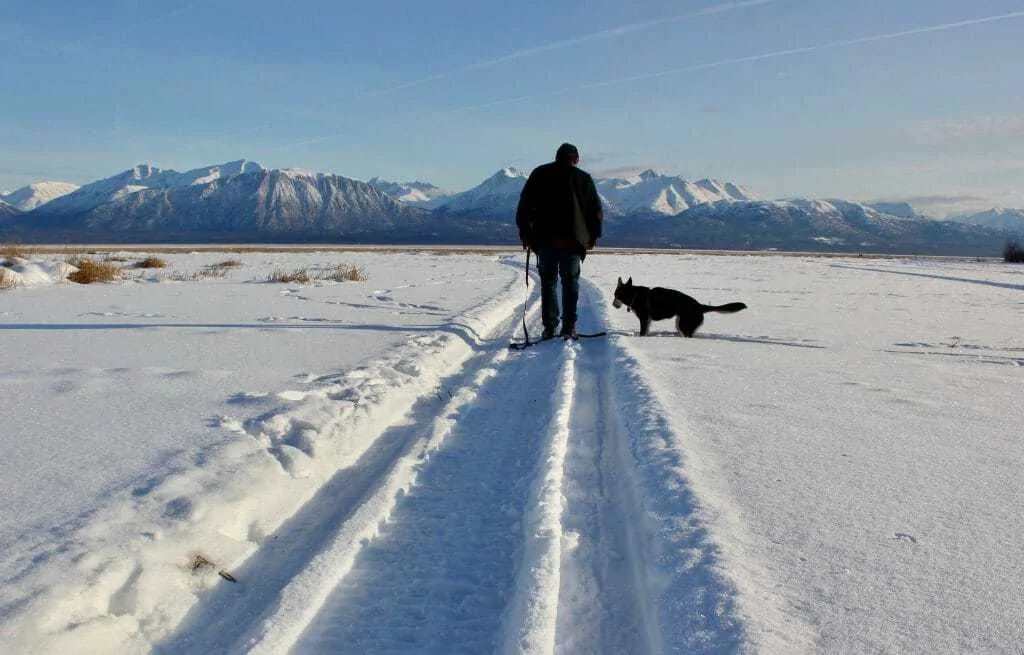When we brought our Alaskan shepherd —the name for a mix of the Alaskan malamute and German shepherd breeds—puppy home at eight weeks old, I thought it would be easy to potty train her. The breeder had told me she already went to the door when she needed to go out. I figured she would have one or two accidents and then be thoroughly potty trained.
I was wrong. On her first day home, she pooped and peed inside dozens of times. I tried to remember to let her out every half hour, but it was November. The dead of winter here in Alaska: freezing cold, icy, and dark. I completely missed her cues and spent my days mopping up puddles of pee.
Even though friends suggested buying a crate and using it to help potty train my new puppy, I didn’t. The idea is that dogs don’t eliminate in their sleeping spaces, so you can keep your dog in a crate some of the time to teach her that the crate (and the house around it) is not a potty.
Who wants to spend the day potty training in a crate when there’s a couch to chill on?
To me, that seemed like too much time in a crate. I did eventually get one for my dog, but it’s only for nighttime. She spends her days dozing on the couch, playing in the backyard, and going for walks.
I potty trained her entirely without the crate. I learned a lot along the way, and if you’ve just brought home a new puppy and want to avoid using a crate to potty train, I have an armload of tips for you.
The biggest thing to know before you start is that crate-free potty training is not quick, but it’s worth it. You won’t immediately have to spend 80+ dollars on a good crate, and you won’t have to crate your dog at all while you’re home with her. All her time with you can be bonding and learning time!
Contents
Pick A Word
Decide what word you’re going to use for the potty. I chose the word outside because it’s simple. You can also use yard, potty, lawn, grass, or any word that seems natural and comfortable.
Make sure you have a designated area you want your dog to learn is the potty. If you don’t want her to get used to peeing and pooping in the front yard, for example, then avoid taking her there to eliminate.
I made that mistake at first because it seemed easier to whisk my puppy out the front door than the back door. Then I got tired of picking up poop and pee spots in the snow every time guests came over. So I decided to start encouraging her to go potty in the backyard. Now that she’s potty trained, she never goes in the front. Even if we’re playing there, she’ll wait until she’s in the backyard and go potty there.
Eira in her clean potty yard. She also has a dog house in case she is out for a half hour or so and gets cold. Use a hay/straw blend from your local animal supply store to provide a clean, comfortable potty and outdoor rest area in winter.
Know Your Puppy’s Cues
You’ve just met your pup—how are you supposed to know her cues? The thing is, learning your dog’s cues is essential to potty training. After that first potty-training disaster day, I studied my dog, Eira, closely. I figured out that if she started sniffing, even a little bit, I needed to take her out. Or if she started whining more than usual, or barking. Or if she started squatting.
That last one is obvious. The thing to remember, though, is that even if your dog is squatting to pee or poop, it’s not too late to take her out. But—and this is crucial—don’t scare her. Avoid yelling “NO!” or “What are you doing??” while you snatch her and plop her in the yard.
Instead, act quickly and calmly. Speaking gently to your pup, remind her that outside is the place to do her business. Repeat the word several times. For example, “We go outside, Eira. Outside is for potty, okay? You needed to go outside. Let’s finish going potty outside.”
And when she does pee or poop outside in the designated potty spot, reward her with a simple “You did it!”, a smile, and a small treat.
Eira and her post-potty treat.
Before long, your puppy will figure out which door leads to her potty area. Her biggest cue will be standing by the door and pawing or staring at the door knob.
Showing her door cue to use the potty.
Get An Enzymatic Spray
You will need to clean up thoroughly after each indoor accident. If a dog smells where she’s peed or pooped before, she’ll want to go there again. This trait is actually a good thing. If she eliminates a lot in a certain spot outside, she’ll keep going there and it will become her restroom. In nearly every case, her chosen restroom will be away from her outdoor dog house and any food or water dishes outside.
You just don’t want that restroom to be your carpet.
My favorite spray, from Nature’s Miracle, is made specifically for dog pee, poop, barf, and any other liquid that could come from a dog. The spray reacts with the bacteria in the elimination to create an enzyme that breaks residue down into nothing in about ten minutes.
I suggest cleaning the mess away with a towel or toilet paper first. Then hit the stained area with the spray, leave it for ten minutes, and wipe it up completely.
Crate-free potty training essentials.
The Nature’s Miracle spray smells light and fresh to me, yet during potty training it prevented my dog from peeing in the same spots over and over.
Avoid Showing Frustration
Crate-free potty training is going to take time, but it will happen. My puppy had countless accidents in the first two weeks of potty training, but after that they became rarer with each week that passed.
Some of the accidents were pretty bad. Once, she peed on my bed in the middle of the night! But instead of getting frustrated, I had to take a deep breath and remind myself that she’s just a puppy.
Accidents can really frustrate you—especially if you thought you were getting somewhere with potty training. Count to ten before getting mad at your dog. Remember, she wants to please you, and your frustration isn’t going to make her get trained any sooner. Getting angry at her could cause behavior problems.
“Please don’t be mad that I peed inside! I’m trying my best to remember.”
As a general rule, puppies can hold their bladders for about an hour per age in months. So, my five-month-old puppy can hold it for about five hours—though I rarely let her wait that long. If you’re home, take your pup out every hour or two even if she isn’t showing cues.
Forget the Schedule
Some say dogs should get on a regular schedule so that they can expect when to go potty. I find, however, that strict schedules aren’t necessary—nor are they convenient. What if you want to go to town one day and you leave your puppy home, and she pees inside her crate because you weren’t there to take her out during her scheduled potty time?
While you might want to use a soft schedule for feeding your dog, all you need to remember is you should take her outside to go potty about a half hour after she finishes her food—whenever that happens to be.
Other important times to let your dog of any age outside to go potty are:
- First thing in the morning.
- In the middle of the night at the first hint of a cue behavior (whining, scratching, wiggling). Note: you won’t have to get up in the night for more than a couple weeks after bringing home a new puppy or dog. They’ll get used to sleeping through without going potty.
- Right before bed.
- Right before you leave the house.
- Immediately after you come home.
- Every hour or two (especially for puppies). For older dogs, every two or three hours while you’re home, and never more than eight hours while you’re away. If you have to be gone longer than that, ask a trusted neighbor or friend to come over and let your pup out to go potty, play, and have some social interaction.
- Half an hour or forty-five minutes after a meal.
- Half an hour or forty-five minutes after drinking a lot of water.
Patience and Consistency Win the Race
By following the steps above, you’ll soon have a potty-trained dog. You don’t need fancy rewards, detailed schedules, or a crate. All you need is patience and consistency in following the steps you use to gently potty train your pup.
Before you know it, potty training will be a distant memory and you’ll have a loving companion who knows that your home is not their potty area.
Enjoying Alaska’s wilderness with our potty-trained, five-month-old Alaskan shepherd.

Laura Ojeda Melchor grew up with two beloved German shepherd dogs—Clancy and her daughter, Bella. From the time her family brought Clancy home, Laura took on the duty of pooper-scooper and potty trainer. As a teenager Laura helped her mother care for Clancy during her pregnancy. She still remembers fondly the exciting, frigid winter night when the seven special puppies were born. Laura kept the youngest puppy—Bella—and potty trained her, too. She taught Bella important commands, took her for long walks, and spent hours throwing tennis balls for her.
In November, Laura brought home a sweet new puppy, Eira Violet. Eira is half Alaskan malamute and half German shepherd, and Laura loves her deeply. She chose not to use a crate to potty train Eira and was pleasantly surprised at the results. She now has a sweet, energetic dog who always uses the potty outside, plays well with Laura’s toddler, and enjoys long family walks in beautiful Alaska. If you were to meet Eira, she’d bound up to you with a wagging tail and get you running around the yard with her in no time.
